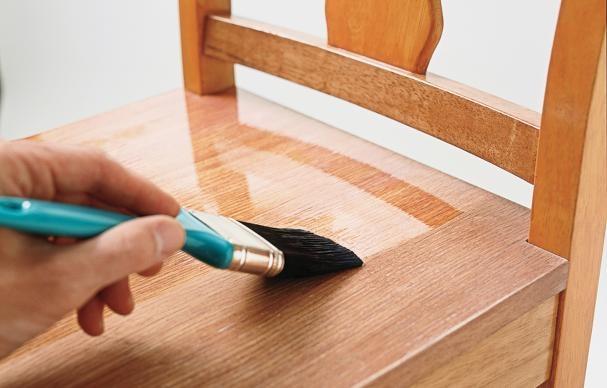From time to time I log on to the profile groups to see the new topics members are posting, as well as the problems they are having and the advice they are receiving. Although I love all things wood, I watch the finishing related posts more closely. It is the area in which I specialized many years ago and for which I still have a great passion. In the groups there are always newbies who call on the knowledge of the "veterans" asking what wood varnish to use, what lazura wood is the most durable or which wood paint would be best for his small project. From the recommendations I realize that there are many rightly attached to good professional brands, which they highly recommend. I understand their enthusiasm, but the end result depends not only on the quality of the materials. For years I have told those I work with that materials are very good, but they can't work wonders. And I'll tell you why.
When to use professional finishing materials and why sometimes it's better to turn to DIY stores
In the wood varnishes and paints market, there are two main product groups, industrial and DIY. The former are sold by manufacturers or their distributors, the latter you can find in DIY stores. Industrial products are often sold after a visit by an agent to the workshop or factory, while the others you buy yourself in the store and try to find out as much as you can about the product and how to use it from the store representatives or the label.

Professional materials
Professional varnishes and paints are made to be applied under certain conditions and with certain devices (spray gun, molding machine, wand). technical data sheets, which you should receive with your first shipment, the product is described, as well as the conditions to be met in order to get the best result.
It mentions the temperature in the working area, what to apply, how much to thin, how to sand, how thick the varnish should be, and much more. You will always find a note at the end saying that sometimes the result can be altered by factors directly related to the place where the finishing is done.
It may happen that the same product applied to temperature too low or too highwith a gun with a nozzle too big or too small or in a space with much dust to look different than one applied according to the instructions. More is expected of industrial products than DIY ones, which is why their composition sometimes includes materials that increase their sensitivity. They are also part of systems, technologies where it is recommended to apply certain primers under varnish or some kind of sanding paper. They cannot just be used anyway and end up with perfect results. I am convinced that those who recommend the products apply them as instructed by a company technician, which makes the results very good.

DIY products
When you make a wooden chair or table for the first time and you want to varnish it, I doubt that you can comply with the conditions in the technical data sheet of a professional product. Nor will you get assistance from a company technician unless he is a friend. So your best bet is to go for DIY products.
These products are specially formulated to be applied at home with a paintbrush, paint brush, squeegee or even a rag, under less stringent conditions than factory conditions. The result will not be perfect, but acceptable for a personal project. You will not need sanding between layers for grip, nor dust-free atmosphere for a decent sheen. You will not have to buy 2-3 types of products to apply in succession, but one product will deliver the desired result.
And in the DIY range there are many value brands with which to achieve very high quality finishes. Many manufacturers of industrial finishing materials also have special divisions for DIY products, precisely to offer quality products also to those who work on personal projects at home.
If, after a few such projects, you're thinking of taking it to the next level, then turn to professional products. Until then, however, it's best to avoid them because you may not get the result you want and you may lose confidence in a good brand just because you can't follow its recommendations.

Nitrocellulose varnish is the oldest and most versatile varnish, but it cannot be recommended for every job. It has its limits!
Another material that I have seen recommended many times, regardless of the subsequent use of the finished object, is nitrocellulose varnish. It is considered a sort of universal panacea. I have also seen it recommended for fencing or other outdoor landscaping.
Nitrocellulose varnish is one of the oldest and most versatile varnishes, but it cannot always be used for exterior finishes. Indeed, in the past there was only this kind of varnish, but on exteriors, it was not varnish that was used, but oil.
If you want good resistance of furniture to moisture, scratching or mechanical shocks, nitro lacquer is not the one to use. A bathroom or kitchen furniture finished with nitrocellulose varnish and on which water drips or even splashes, will over time flake.
For such conditions, catalyzed hardening varnishes are recommended - polyurethane, acrylic, polyester. They are much stronger varnishes. But even in this case the application instructions must be followed to achieve the desired result. So, if you're making a table for the first time and want to varnish it, don't think of a polyurethane varnish first. You might more likely create problems. Go for a DIY product that will sufficiently protect the table. In time you will also learn how to remedy problems that may occur.

In conclusion:
- Turn to DIY products if you're just a wood enthusiast making something to protect for the first time.
- Always read the label for recommendations. If you need an outdoor product look for that specification. If it's not listed - don't get it.
- Don't expect to get great results just because you use a name brand product. When finishing wood, working conditions and technology are just as important.
- If you are a professional, but have never worked with a particular product before, don't rely on experience. Ask the supplier about conditions and application technology. Varnish types can be very different and so can the results.
- Do not use nitrocellulose varnish for any kind of finishing. It is a varnish with many qualities, but by no means universal.
Good luck!


































I'm not familiar with abbreviations: what does DIY mean?
DIY = do it yourself
The term used for DIY stores.
DIY varnishes are the ones from such stores that we buy for projects we have at home: painting a piece of furniture, a fence, a patio, etc.
All the best!
Thank you!
Hello.
I have read several articles related to wood finishing, but I still have some questions and I would be very grateful if you could help me with an answer.
1) For the realization of a pine wood gazebo, do you have an article already written in which you present all the necessary steps to finish it? White sanding, priming (if applicable), sanding again, applying linseed oil or maybe lacquer is better. I searched through the articles already posted, I found suggestions for treating exterior wood, but I seem to have seen more for hardwood.
1.1) Also related to the veneer, do you recommend sanding the used wood, or is just sanding with 80-120 enough? I know that the results are different, as we are talking about different mechanical processes, but I am curious which option is recommended to keep an authentic look.
2) What do you recommend for treating OSB outside? We are talking about a small tool shed, so it is out of the question to cover with polystyrene and plaster like a normal wall. I understand the paint would peel over time. Am I to understand that here too linseed oil or lacquer would be more recommended?
Thanks in advance!
Hello.
1. We don't have a pine arbor, but the finish is not very different from hardwood. Softwood (spruce, it's the one we mainly use) is widely used outdoors and its resistance is good. It needs to be sanded more carefully because it is more "flaky" compared to hardwoods - oak, acacia. The wood should be sanded at min.150, even 180 to obtain smooth surfaces. Generally, exterior varnishes can also be applied layer by layer. In this case there is no need for primer. For a smooth surface, sand between coats with 280 or 320 paper or fine abrasive sponges. If the label or seller recommends primer beforehand then apply 2 coats of primer and one coat of varnish.
The drying oil protects well against humidity, but not against UV radiation. For this protection it must contain a quantity of pigment. The oil contains pigments and is therefore more resistant than plain oil.
1.1. I recommend sanding because the wood needs to absorb inside and it does it better when the wood is "scratched", There are several fiber ends that absorb the protective substances (oil, impregnant).
2. You can protect it by painting it with an exterior resistant paint (oil-based paint). The problem with peeling is that it absorbs harder and cannot "stick" to the wood. Try a light sanding before painting. But with OSB the problem is in the cut areas, on the edges. That's where it starts to absorb and swell. Those areas need to be as well protected as possible and protected from moisture.
I hope that was helpful.
All the best!
Don't forget to subscribe to the printed Wood Magazine! For only 58 lei/year you can find out news in the field, discover craft ideas or trade secrets. We remind you that the content in the printed magazine is different from the one on the website. Details in the link below.
Thank you!
https://revistadinlemn.ro/product/abonament-revista-din-lemn/